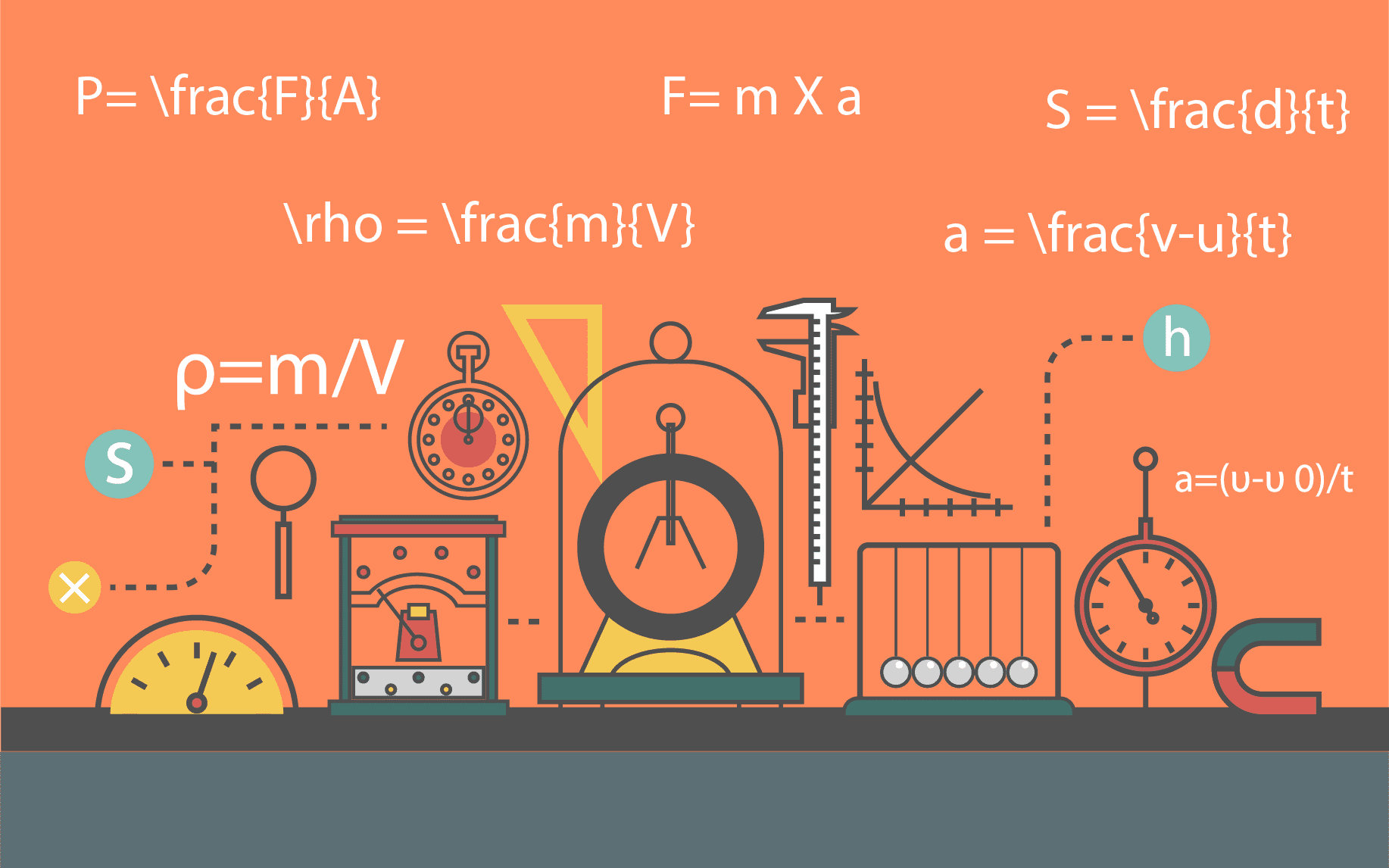Basic Physics Formulas & Notes for Competitive Exams
Do you ever think about why the sky is blue or how the gravity works? Physics essentially studies… The post Basic Physics Formulas & Notes for Competitive Exams appeared first on Leverage Edu.


Do you ever think about why the sky is blue or how the gravity works? Physics essentially studies how the fundamental constituents of our universe interact. Comprising an imperative part of the syllabus for many competitive exams organised for admission into engineering and technical programmes, this discipline constitutes a varied range of sub-fields ranging from quantum physics to nuclear physics. This blog aims to provide you with a comprehensive list of basic Physics formulas that you must know to ace your chosen competitive exam.
Check Out: English for Competitive Exams
List of Basic Physics Formulas
Here are some basic physics formulas for competitive exams-
| Basic Physics Formulas | Concept | Formula |
| Average Speed Formula | It is used to calculate the average speed (S) of a moving body for the distance covered (D) as well as the time duration (T). | S = d/t |
| Acceleration Formula | Acceleration refers to the rate of change in velocity to the change in time. It is denoted by symbol a. | a =(v-u)/t |
| Density Formula | This formula depicts the denseness of material in a specific given area. | P=m/V |
| Power Formula | The capacity to perform an activity is known as Energy. On the other hand, energy spent in carrying out an activity (work) for a particular period of time is termed as Power. | P=W/t |
| Newton’s Second Law | Using the formula, the force can be expressed by the product of mass and acceleration of the body. | F = ma |
| Weight Formula | The formula measures the force with which an object falls due to gravity. | W=mg |
| Pressure Formula | Pressure refers to the amount of force applied per unit area of the object. | P=F/A |
| Ohm’s Law Formula | Ohm’s law states that the current passing through a conductor material is directly proportional to the potential difference between two endpoints of the conductor. | V= I × R |
| Kinetic Energy Formula | Kinetic energy is the energy that is possessed by a body due to its state of motion. | E = 1/2 mv² |
| Frequency Formula | Frequency refers to the revolutions completed per second or as the number of wave cycles. | F =v/λ |
| Pendulum Formula | This equation calculates how long the pendulum takes swing back and forth in seconds | T = 2π√Lg |
| Fahrenheit Formula | This is a conversion formula for a temperature. | F = (9/5× °C) + 32 |
| Work Formula | The work formula measures the multiplication of magnitude of displacement d and the component of the force. | W = F × d × cosθ |
| Torque Formula | Torque is rotational force or turning effect. It measures the magnitude of | T = F × r × sinθ |
| Displacement Formula | Refers to the change in the object’s position from its initial place to its final position. | D = Xf–Xi = ΔX |
| Mass Formula | This formula represents the relationship between force and mass. Here, F = force, m = mass, and a = acceleration. | F = ma or m = F/m |
Popular Basic Physics Formulas
- Average Speed Formula
Using this Physics formula, we can calculate the average speed (S) of a moving body for the distance covered (D) as well as the time duration (T).
- Density Formula
This formula depicts the denseness of material in a specific given area.
- Acceleration Formula
Acceleration is the rate of change velocity with respect to the change in time.
- Power Formula
The capacity to perform an activity is known as Energy. On the other hand, energy spent in carrying out an activity (work) for a particular period of time is termed as Power.
- Pressure Formula
The amount of force applied per unit of an area is referred to as the pressure of an object.
- Ohm’s Law Formula
Amongst the popular Physics formulas, the Ohm’s Law is explained as the current (I) passing through some conductor material is directly proportional to the potential difference (V) between the two endpoints of the conductor.
Exploring Physics formulas? Check out Trigonometry Formulas for Quantitative Section in Competitive Exams
Basic Physics Notes
To crack any competitive exam, familiarizing oneself with the syllabus and exam pattern is of paramount importance. Considering the vast number of applicants every year, one cannot deny the fact that, to grab a tantalizing score you must learn the intricacies on your tips. Often, the important concepts are prepared by everyone but what fetches the extra marks there is the knowledge of the minute concepts of the subjects. While you must strengthen your basic Physics formulas, it is also imperative to go through the fundamental concepts under this subject. To help you strengthen the varied Physics concepts, we have explained some of the frequently asked topics under this discipline.
Check Out: Analytical Reasoning For Competitive Exams
SI Units
Questions regarding the SI unit are frequently asked in many engineering exams. Here are the key pointers you must remember under SI units along with the basic physics formulas mentioned above. SI units as a concept are given less importance but they hold a very significant presence in questions papers of various exams. Following are some of the important SI you must remember and apply in your basic physics formulas.
| Name of the Quantity | SI Unit | Name of the Unit |
| Mass | Kilogram | Kg |
| Time | Second | s |
| Length | Metre | m |
| Thermodynamic/ Temperature | Kelvin | K |
| Electric Current | Ampere | A |
| Luminous | Candela | Cd |
| Amount of Substance | Mole | Mole |
| Electric Resistance | Ohm | Ω |
| Power | Watt | W |
| Wavelength of Light | Angstrom | Å |
| Magnetic Induction | Gauss | Gs |
| Electric Charge | Coulomb | C |
| Atmospheric Pressure | Bar | bar |
| Energy | Joule | J |
| Magnetic Flux | Maxwell | Mx |
| Pressure | Pascal | Pa |
| Force | Newton | N |
Important Instruments and Devices
Most of are only aware of common devices or instruments used in various experiments of physics. These instruments can be incorporated in varied questions to evaluate a student’s understanding of basic physics concepts and formulas. Take a look at the following which enlists these instruments and devices as well as their simplified definitions.
Also Read: LCM and HCF for Competitive Exams
| Instruments | Functions |
| Speedometer | A device used to measure and display the speed of a vehicle. |
| Accelerometer | It is a device that measures acceleration. |
| Dynamometer | Usually, this device is used for measuring the torque, force as well as the power of a body. |
| Anemometer | Through this device, we can measure the speed of the wind. |
| Galvanometer | It is an electromechanical instrument which is utilised for detecting and indicating the electric current. |
| Barometer | A barometer is a scientific instrument which has its application in meteorology and is used to calculate the atmospheric pressure. |
| Viscometer | Through this device, we can calculate the viscosity of a fluid. |
| Seismometer | This instrument helps in assessing and measuring the random motions inside the earth’s crust caused by an earthquake or volcanic eruption etc. |
| Voltmeter | By using a voltmeter, we can measure the electrical potential difference between two given points |
Practice Questions
- The width of a door is 40 cm. If it is released by exerting a force of 2 N at its edge (away from the hinges). Compute the torque produced which causes the door to open.
- A pendulum’s length is 4 meters. It completes one full cycle of 0.25 times every second. The maximum displacement that the pendulum bob reaches is 0.1 meters from the centre. Find out the time period of the oscillation? And what is the displacement after 0.6 seconds?
- A pendulum has a period of 1.90 s on Earth. What is its period on Mars, where the acceleration of gravity is about 0.37 that on Earth?
- Let’s consider a man is pushing a lawnmower across a yard and the force that he is applying to the handle is angled down at 60^o from the horizontal plane. Besides, the force has a magnitude of 900 N. So, if he pushes the mower 30 m. Then calculate the work done by the person to move the lawnmower.
- A wave has a frequency of 50 Hz. It also has a wavelength of 10 m. Find out the speed of the wave?
- Suppose Geeta leaves Delhi to visit Rohit in Delhi. She decides to travel by train and covers 350 kilometres to the north. Then the track turns back to the south of 125 kilometres. Calculate Geeta’s total displacement using the displacement formula?
- A box that weighs 250 N is at rest on the floor. If the pressure exerted by the box on the floor is 25,000 Pa, over what area is the box in contact with the floor?
- The mass of an object happens to be 1 kg. Furthermore, a force of 2 Newton is applied on it. Find out the magnitude and direction of the object’s acceleration.
- A person’s mass happens to be 70 kg, while the gravity on Earth is 9.8 m/s2. Find out the weight of this person?
- Calculate the gravitational force which acts upon two objects of masses 15 g and 15 kg which are 11 m apart?
Thus, we hope that this blog has equipped with the basic physics formulas and concepts you must know while preparing for competitive exams. If you are gearing up for competitive exams like GRE and GMAT, book an online demo session with our Leverage Edu experts and we will guide you through your preparations, providing you with the best study material and exam day tips to crack your exam with flying colours!
The post Basic Physics Formulas & Notes for Competitive Exams appeared first on Leverage Edu.

![How To Obtain NECO GCE Registration Form For 2022/2023 (June/July) SSCE Internal Examination [Released And Published Online]](https://i0.wp.com/micplustech.com/wp-content/uploads/2020/02/images-33.jpeg?fit=602%2C510&ssl=1)







